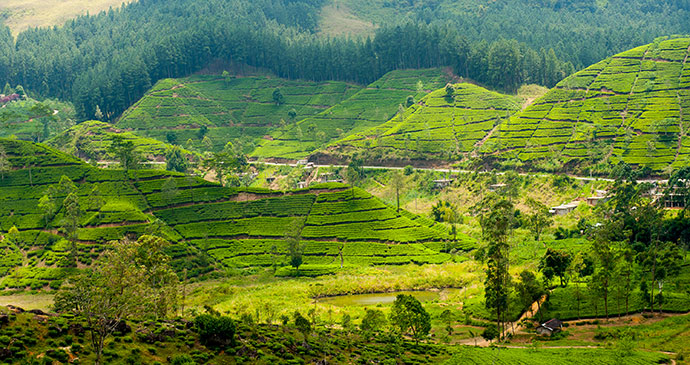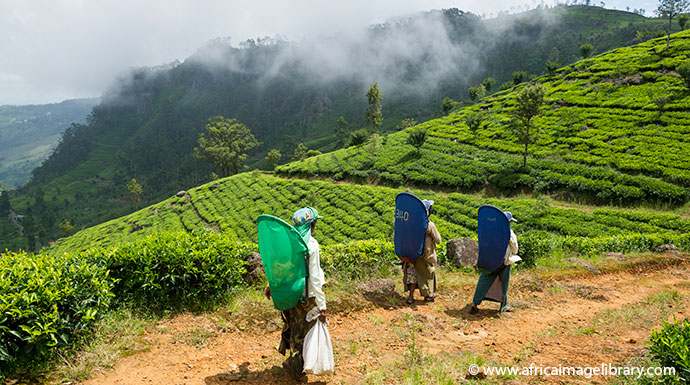Written by Royston Ellis
 Tea plantations are found in Sri Lanka’s hill country © Anton Gvozdikov, Shutterstock
Tea plantations are found in Sri Lanka’s hill country © Anton Gvozdikov, Shutterstock
Tea was first grown in Ceylon in 1824 at the Botanical Gardens at Peradeniya when a few plants were brought from China; more were introduced from Assam in 1839. In 1867 (the year the railway reached Peradeniya), a Scottish planter, James Taylor, planted tea seedlings on 8ha of forest land which had been cleared for coffee growing.
Taylor’s foresight was remarkable because two years later a blight wiped out the country’s coffee crop. The island’s planters turned to tea and had 400ha flourishing by 1875. In 1965, Ceylon displaced India as the world’s biggest tea exporter, and tea is one of the major foreign-exchange earners for Sri Lanka.
The large tea (and other) estates were nationalised in 1972, leaving individual owners with only 20ha. The process was reversed 20 years later and plantations were leased to management companies and the private sale of tea allowed (instead of exclusively through the weekly tea auction). The industry is going through a period of streamlining, with the result that more specialist (single estate, organic and green) teas are available.
The best Ceylon teas are known as ‘High Grown’, from plantations at heights above 1,200m, where the climate has a crucial effect on quality. The finest teas, from the Uva district, are produced in the middle of the year when that region is swept by very dry winds and the tea takes on its characteristic refreshing flavour. Teas from the other, western side of the main range of hills, from Nuwara Eliya, Dimbula and Dickoya, show their best quality in January and February after the northeast monsoon, when dry weather and cold nights predominate. The flavour of Nuwara Eliya tea is quite distinct from Uva, though the two districts are neighbours, which illustrates how sensitive tea is to soil, environment and climate.

‘Low Grown’ teas, mostly produced on private estates in the Matara, Galle and Ratnapura districts of southern Sri Lanka and bought more for leaf appearance than taste, grow at sea level up to 600m. ‘Medium Grown’ teas, which produce a liquor with a rich, mellow taste and good colour, are grown at heights of between 600m and 1,200m.
The journey from bush to tea taster’s spoon takes 24 hours, although it could be months before the same tea is used to make one of the billion cups brewed around the world every day. The tea bush is actually an evergreen tree called Chinese camellia (Camellia sinensis), which could grow 10m high if not pruned every two or three years. The pruning encourages the repeated growth of a ‘flush’ of fresh young shoots throughout the year. These shoots, of two top leaves and a tender bud, are plucked every six to ten days.
On arrival at the tea factory from the field, the leaves are spread out in troughs to wither until they lose their moisture and go limp. The 100kg of green leaf in each trough is reduced to 50–55kg during this period. The withered leaves are fed into a rolling machine, which crushes their cell structure, releasing the natural juice and enzymes that give tea its flavour. The leaves emerge from the machine in twisted, sticky lumps. Oxidisation, called fermentation, takes place then in about three hours, changing the pulverised green leaf into a light, coppery shade through the absorption of oxygen. Firing (drying) in a hot-air chamber for about 20 minutes halts the ‘fermentation’, kills off any bacteria, dries the tea and preserves it, further reducing the original 100kg to 24kg.
The fired leaf is left to cool before being sifted. The main commercial leaf grades are Orange Pekoe (OP), Pekoe (Pek) and Flowery Pekoe (FP). Broken leaf grades are Broken Orange Pekoe (BOP), Broken Pekoe (BP), Fannings (F) and Dust. BOP grades are used in traditional packet blends, while Fannings and Dust find their way into tea bags. CTC tea, so called because the leaf is cut, torn and curled by machine instead of rolled, is also produced in Sri Lanka as tea-bag-quality tea.
While tea is sold at auction in Colombo to traders who buy different grades and qualities for export and blending, it is now possible to buy pure, unblended estate teas in shops in Colombo. The major retail outlets for speciality teas (packed in gift containers) are the Mlesna shops to be found in the Crescat, Liberty Plaza and Majestic City shopping centres, as well as in Beruwala, Bandarawela, Nuwara Eliya, Kandy and the airport departure lounge.
Want to learn more about the Sri Lanka? Check out our comprehensive guide:

